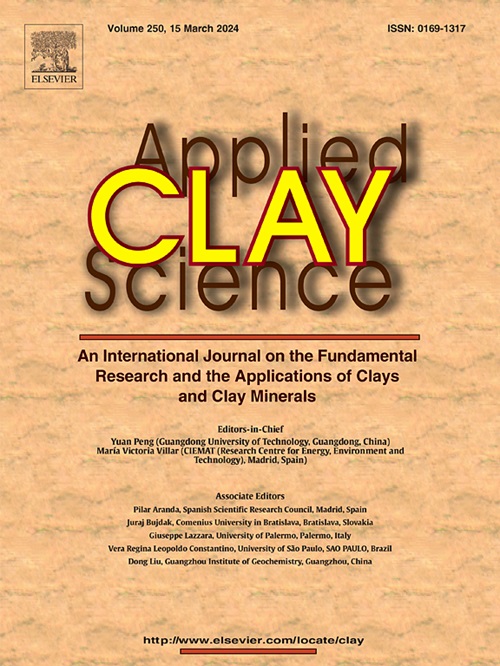An enhanced electrokinetic system for remediation of Cu-polluted clay soils by integrating purging solutions and intermittent power
IF 5.3
2区 地球科学
Q2 CHEMISTRY, PHYSICAL
引用次数: 0
Abstract
This study investigated the effectiveness and underlying mechanisms of purging solutions enhanced by intermittent power in improving electrokinetic (EK) restoration of clay soils even under high levels of heavy metals (HM). In so doing, the artificially contaminated specimens containing a wide range of copper (Cu) were prepared and then subjected to a series of EK tests with various electrolytes and electric regimes. Macro and micro scale examinations revealed that under the unenhanced EK condition (i.e., continuous current without agents), the formation of non-conducting solid phases and/or the clogged fabric in the samples with the high dosages (> 250 mg/kg) of HM could dramatically impede the metal separation from the soil. Hence, increasing the remediation time would not be very effective in facilitating the decontamination process. It was observed that the EDTA-ameliorated treatment accompanied by pentetic acid and acetic acid can mitigate the metal precipitation/encapsulation effects induced by EK actions, resulting in improved rate of HM removal. In this case; however, a high portion of these enhancers would be required to ensure the stable mobility of ions and to achieve successful recovery. Such a limitation has been shown to be overcome by incorporating pulsed power (PP) at an optimal frequency. In fact, as evidenced by SEM-EDX and XRD analyses, the integration of chemical agents with PP could simultaneously retain the solubilized Cu species in the soil mass and modify the matrix tortuosity (i.e., the establishment of well-linked pores), two features that have been found to play essential roles in providing for favorable activity of HM ions during the EK operation. The corresponding refinements in the binary system would cause an almost 8 folds increase in the removal efficiency and a shorter (up to 30 %) time of treatment compared to conventional EK.
通过整合净化溶液和间歇式电源,改进用于修复铜污染粘土的电动系统
本研究调查了间歇性电源增强的净化溶液在改善粘土的电动力(EK)修复(即使在重金属(HM)含量较高的情况下)方面的有效性和基本机制。为此,我们制备了含有多种铜(Cu)的人工污染试样,然后用不同的电解质和电机制进行了一系列电动力测试。宏观和微观检测结果表明,在未增强的电解池条件下(即无药剂的持续电流),高剂量(250 毫克/千克)HM 样品中形成的非导电固相和/或堵塞的织物会极大地阻碍金属从土壤中分离出来。因此,延长修复时间并不能有效促进去污过程。据观察,乙二胺四乙酸(EDTA)与戊乙酸和乙酸的混合处理可减轻 EK 作用引起的金属沉淀/包裹效应,从而提高 HM 的去除率。不过,在这种情况下,需要大量使用这些增强剂,以确保离子的稳定流动性,并实现成功回收。事实证明,在最佳频率下加入脉冲电源 (PP) 可以克服这种限制。事实上,SEM-EDX 和 XRD 分析表明,将化学制剂与 PP 结合使用,可同时将溶解的铜离子保留在土体中,并改变基质的曲折性(即建立连接良好的孔隙),这两个特征已被发现在 EK 运行期间为 HM 离子提供有利活性方面发挥了重要作用。与传统的 EK 相比,二元系统的相应改进将使去除效率提高近 8 倍,处理时间缩短(最多 30%)。
本文章由计算机程序翻译,如有差异,请以英文原文为准。
求助全文
约1分钟内获得全文
求助全文
来源期刊

Applied Clay Science
地学-矿物学
CiteScore
10.30
自引率
10.70%
发文量
289
审稿时长
39 days
期刊介绍:
Applied Clay Science aims to be an international journal attracting high quality scientific papers on clays and clay minerals, including research papers, reviews, and technical notes. The journal covers typical subjects of Fundamental and Applied Clay Science such as:
• Synthesis and purification
• Structural, crystallographic and mineralogical properties of clays and clay minerals
• Thermal properties of clays and clay minerals
• Physico-chemical properties including i) surface and interface properties; ii) thermodynamic properties; iii) mechanical properties
• Interaction with water, with polar and apolar molecules
• Colloidal properties and rheology
• Adsorption, Intercalation, Ionic exchange
• Genesis and deposits of clay minerals
• Geology and geochemistry of clays
• Modification of clays and clay minerals properties by thermal and physical treatments
• Modification by chemical treatments with organic and inorganic molecules(organoclays, pillared clays)
• Modification by biological microorganisms. etc...
 求助内容:
求助内容: 应助结果提醒方式:
应助结果提醒方式:


